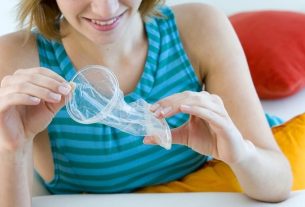The contraceptive implant is a contraceptive method that consists of a small silicone tube measuring approximately 3 cm in length and 2 mm in diameter and which can be placed in the woman’s arm between the 1st and 5th day of the menstrual cycle, under local anesthesia. .
This implant works by continuously releasing hormones into the bloodstream to prevent ovulation and promote endometrial atrophy, which prevents pregnancy.
The contraceptive implant, whose commercial name is Implanon, must be applied by the gynecologist in the office after evaluating the woman’s general health.

How the implant works
The contraceptive implant is made up of a large amount of etonogestrel, which is a synthetic female hormone that has effects similar to progesterone. Etonogestrel is gradually released into the bloodstream over 3 years, preventing ovulation. Therefore, there are no mature eggs that can be fertilized by sperm if unprotected sexual intercourse occurs.
Furthermore, this method also makes the mucus in the uterus thicker, which makes it difficult for sperm to pass to the Fallopian tubes, the place where fertilization normally takes place.
The contraceptive implant also alters tubal motility, so that if ovulation occurs, the egg cannot be moved along the fallopian tube, and promotes endometrial atrophy, preventing implantation of a possible embryo and, consequently, preventing the development of pregnancy. .
Main advantages
The contraceptive implant has several advantages such as the fact that it is a practical method and lasts for 3 years, avoiding having to take the pill every day. Furthermore, the implant does not interfere with intimate contact, improves PMS symptoms, allows the woman to breastfeed and prevents menstruation.
Possible disadvantages
Although it has many advantages, the implant is not the ideal contraceptive method for everyone, as there may also be disadvantages such as:
- Irregular menstrual period, especially in the first few months, which may include absence of menstruation, breakthrough bleeding or excessive menstruation;
- Slight increase in weight;
- Changes in mood, nervousness or depressed mood;
- Decreased libido;
- It needs to be changed at the gynecologist.
Another disadvantage is that the implant does not protect against sexually transmitted infections, and a barrier contraceptive method, such as a condom, must be used.
Main side effects
The most common side effects related to the contraceptive implant are irregular menstrual periods, weight gain, headache, stomach pain, mood changes, vaginitis, breast pain, nausea, dizziness, acne and decreased libido.
Who shouldn’t use
The contraceptive implant is a safe contraceptive method, however it is not recommended for women who have active venous thrombosis, in case of benign or malignant liver tumor, severe or unexplained liver disease, vaginal bleeding without specific cause, breast cancer, during pregnancy or if pregnancy is suspected.
Most common questions about the implant
Some of the most common questions about using this contraceptive method are:
1. Are there any symptoms after removing the implant?
After removing the contraceptive implant, the woman’s arm may become more sensitive and swollen, and there may also be burning and dark spots in the area where the implant was located.
2. Is it possible to get pregnant?
The contraceptive implant is as effective as the pill and, therefore, unwanted pregnancies are very rare. However, if the implant is placed after the first 5 days of the cycle, and if the woman does not use a condom for at least 7 days after the implant is placed, there is a higher risk of becoming pregnant, as there are not sufficient amounts of hormones that work to prevent pregnancy.
It is also possible to get pregnant when a woman forgets the implant’s expiration date, so if she has unprotected intercourse 3 years after the implant was placed, there is a greater chance of pregnancy.
3. How is the implant placed?
The implant must always be placed by a gynecologist after anesthesia at the implant site, which must be placed in the arm with the help of a device similar to an injection. The implant can be removed at any time through a small cut in the skin, after placing light anesthesia on the skin.
The device must be placed between the 1st and 5th day of menstruation under the skin, on the upper inner part of the non-dominant arm, that is, the one that is not used for writing.
4. When should you change?
Normally, the contraceptive implant is valid for 3 years and must be changed before the last day, as after that moment the woman is no longer protected against a possible pregnancy.
5. Does the implant make you fat?
Due to the hormonal changes caused by the use of the implant, some women may tend to gain weight more easily in the first 6 months. However, if you maintain a balanced diet, weight gain may not occur.
6. Does the implant protect against STIs?
The implant only prevents pregnancy, as it does not prevent contact with bodily fluids, it does not protect against sexually transmitted infections such as AIDS or syphilis, for example. Therefore, even with the placement of the implant, it is important to use a condom during all sexual relations.
7. How is the implant removed?
To remove the implant, the doctor must palp the arm to identify the location where the implant is. You will then mark the end of the device and disinfect the skin. Afterwards, local anesthesia is given and a small cut will be made to remove the implant.
After removing the contraceptive implant, the doctor will close the cut, either with specific medical tapes or stitches.
8. Is it possible to get pregnant right after implant removal?
It is possible to become pregnant in the first week after removing the implant, as there is not enough hormone concentration to inhibit ovulation.
9. What medications can reduce the effectiveness of the implant?
Some medications can interact with etonogestrel and reduce the effectiveness of the contraceptive implant, such as phenytoin, barbiturates, primidone, carbamazepine and rifampicin, for example.
Furthermore, other medications can also decrease the effect, such as oxcarbazepine, topiramate, felbamate, griseofulvin, ritonavir, efavirenz and some medicinal plants, such as St. John’s wort.

Sign up for our newsletter and stay up to date with exclusive news
that can transform your routine!
Warning: Undefined array key "title" in /home/storelat/public_html/wp-content/plugins/link-whisper-premium/templates/frontend/related-posts.php on line 12
Warning: Undefined array key "title_tag" in /home/storelat/public_html/wp-content/plugins/link-whisper-premium/templates/frontend/related-posts.php on line 13




